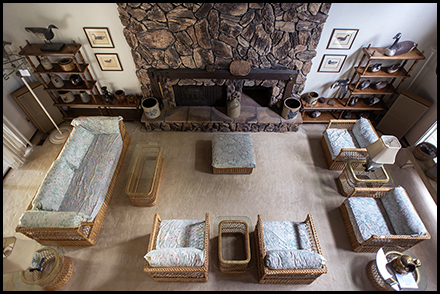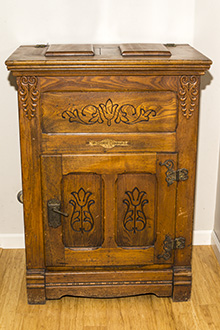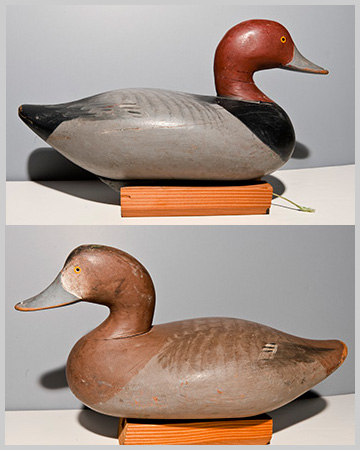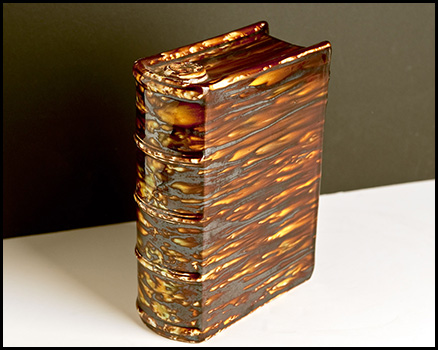 |
|
 |
Fine American Antiques & Folk ArtFrom the mid-seventies to the mid-eighties I collected Folk Art and American Antiques. Initially I was attracted to pottery and decoys because both of these art forms were either signed by their makers or their lineage could be traced through well-illustrated published research. Since relocating, I have decided to offer a few of these items for sale. If you're interested in acquiring any contact me at: 360-306-9120 or at jack@mcbridephotographics.com. NOTE: shipping costs are additional.Shown below are more information and details. |
 |
Pennsylvania Windsor SetteeThis well preserved arrow-back Windsor settee (or settle bench) came out of the Pennsylvania home of Edwin M. Stanton, a lawyer, who served as Abraham Lincoln’s Secretary of War during the Civil War. Shorter than most Windsor settees, at only 48 inches long, it is a very practical piece. The finish is original and has no repairs. Along with a number of our other pieces, this one was acquired in 1985 from June Stout, a well-known Pennsylvania antiques dealer in Prosperity, PA. PRICE $500 |
 |
Leonard Cleanable Ice BoxThis deluxe limited edition chest style ice box is distinguished by it's decoratively carved doors, a paneled lid, and it's highly varnished finish. It was manufactured in the early 1900's by the Grand Rapids Refrigerator Company. It is 41.5" tall x 28" wide and 19" deep. The upper chamber, where a block of ice was placed was 21.5" wide x 12.5" deep. The lower food storage area is 20" x 15". The wood flap on the bottom concealed the removable tray under the box that caught the melting ice water. The zinc racks and paneling inside were enameled for use as a liquor cabinet. Otherwise it's in original condition including decals inside and out. PRICE: $1000 |
 |
19th Century StonewareIn the 19th century a very durable type of pottery was developed that was glazed in a kiln with vaporized salt, and thus became known as 'salt-glazed' ware. In the Northeast the right clay was plentiful and the rivers and canals facilitated the shipping of the raw materials to the potters and the finished goods to their customers. Beginning around 1825 potters began to impress their names into their works. And they also began to decorate them with cobalt drawing as a means of further differentiation. The 3 Gallon Crock on the left was made by J.A. & C.W. Underwood. The Underwood pottery only operated from 1865-67 in Fort Edward, New York; so examples of their work are quite rare. It's in excellent condition other than a small firing stain on the front at the base. Size: 10 1/2” h. 10“ wide. Price: $350 (SOLD) To see more examples visit the Pottery Gallery. Or if you prefer to view a printable file open this Pottery PDF. |
 |
Waterfowl DecoysDecoys are a unique form of American Folk
Art that have been widely researched by
many collectors and scholars.
My small collection of decoys was assembled in the late seventies and
early eighties on excursions up and down the East Coast from North
Carolina to Maine. Plus some pieces were purchased at well-known
antique auctions. Some of the makers signed or marked their work, but The pair of Redhead Ducks on the left were created by R. Madison Mitchell in the 1960's. He was the last of the great upper Chesapeake Bay master carvers (1901-1993). He used a duplicating lathe to turn the bodies, but it’s the painting detail that distinguished his work. These two have strong original paint with some minor To see more examples visit the Decoy Gallery. Or if you prefer to view a printable file open this Decoy PDF file. |
 |
Bennington Pottery 1793-1894There were two potteries in Bennington, Vermont; the oldest was the Norton Pottery which specialized in traditional utilitarian stoneware and the Fenton Pottery which produced more decorative pieces. The two potteries were related by marriage; Christopher Fenton was married to the grand daughter of John Norton. Together they produced the finest and most collectible art pottery in America. Today there is a museum in Bennington, Vermont that showcases their unique work. The piece on the left is a book flask: notice the cork in the top. The finish is a
Rockingham glaze (ref:
Barret PL411). There is a small chip on the front edge of the base but the color and finish is good overall. Size: More examples can be viewed in this PDF file. |
| © 2020 Jack McBride. All Rights Reserved. | |